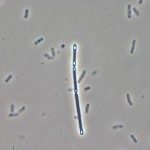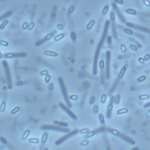Link to Pubmed [PMID] – 9237995
Proc. Natl. Acad. Sci. U.S.A. 1997 Aug;94(16):8439-44
Carbon catabolite repression (CCR) of several Bacillus subtilis catabolic genes is mediated by ATP-dependent phosphorylation of histidine-containing protein (HPr), a phosphocarrier protein of the phosphoenolpyruvate (PEP): sugar phosphotransferase system. In this study, we report the discovery of a new B. subtilis gene encoding a HPr-like protein, Crh (for catabolite repression HPr), composed of 85 amino acids. Crh exhibits 45% sequence identity with HPr, but the active site His-15 of HPr is replaced with a glutamine in Crh. Crh is therefore not phosphorylated by PEP and enzyme I, but is phosphorylated by ATP and the HPr kinase in the presence of fructose-1,6-bisphosphate. We determined Ser-46 as the site of phosphorylation in Crh by carrying out mass spectrometry with peptides obtained by tryptic digestion or CNBr cleavage. In a B. subtilis ptsH1 mutant strain, synthesis of beta-xylosidase, inositol dehydrogenase, and levanase was only partially relieved from CCR. Additional disruption of the crh gene caused almost complete relief from CCR. In a ptsH1 crh1 mutant, producing HPr and Crh in which Ser-46 is replaced with a nonphosphorylatable alanyl residue, expression of beta-xylosidase was also completely relieved from glucose repression. These results suggest that CCR of certain catabolic operons requires, in addition to CcpA, ATP-dependent phosphorylation of Crh, and HPr at Ser-46.

